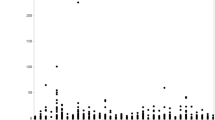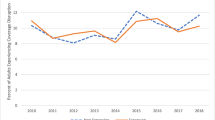Abstract
The Patient Protection and Affordable Care Act (ACA) was designed to provide health insurance to uninsured or underinsured individuals. We used the California Simulation of Insurance Markets (CalSIM) model to predict the experience of consumers in California, who will be faced with new insurance options through Medicaid, employer-sponsored insurance, and the individual market in 2014 and beyond. We explored the response and characteristics of Californians who will and will not secure insurance coverage, with and without the “individual mandate” or minimum coverage requirement (MCR). We found 1.8 million Californians (38 %) of the 4.7 million eligible uninsured will secure coverage by 2019 with the MCR, while only 839,000 (18 % of the eligible uninsured) would obtain coverage without it.

Similar content being viewed by others
Notes
Premium subsidies to purchase health insurance in the Exchange are available to legal residents of the US with household incomes from 100 % to 400% of FPL who are not otherwise eligible for Medicaid. The subsidies are provided in the form of advance premium tax credits (APTC) on a sliding scale based on the second-lowest premium of a silver-rated (70 % actuarial value) plan. The subsidies effectively cap out-of-pocket premiums to a percentage of each household’s income (2 % for households earning 100–133 % of FPL, 3 % for families earning above 133–150 % of FPL, up to 9.5 % for households earning 400 % of FPL).
The federal law requires that all individual and small group insurance premiums sold in the Exchange or outside of the Exchange must abide by the same premium rating rules. The only variation allowed will be based on age (3:1 ratio within the same plan), smoking status, location, and family size (1.5:1 ratios). In California, smoking status will not be allowed as a premium rating factor.
In raking, the sample weights for each classification are repeatedly adjusted such that the sum of the weights converges to total the marginal distributions. The CalSIM raking procedure adjusts the data to match the marginal and joint distributions of age, socioeconomic status, health status and presence of chronic conditions, race/ethnicity, language, and immigration status in 2009 CHIS. We adjust sample weights from MEPS using the Stata module survwgt described at http://faculty.virginia.edu/nwinter/progs/survwgt.hlp.shtml.
In 2013, the Healthy Families Program will be transitioned into Medi-Cal Managed Care plans, meaning that low-income children aged 0–18 will technically be enrolled in Medi-Cal rather than Healthy Families. However, the differences in federal matching funds, cost-sharing requirements, and the federal Children’s Health Insurance Program’s status as an authorized discretionary program rather than a mandatory entitlement like Medicaid make it necessary to continue to differentiate the populations and numbers enrolled in each.
References
Abraham, J. M. (2012). Predicting the effects of the affordable care act: A comparative analysis of health policy microsimulation models. State Health Reform Assistance Network Policy Brief. Retrieved from the State Health Access Data Assistance Center website, http://www.shadac.org/files/shadac/publications/Brief_Microsimulation_Mar2012_0.pdf.
Agency for Healthcare Research & Quality. (2012). Medical expenditure panel survey household component information. Retrieved from http://meps.ahrq.gov/mepsweb/survey_comp/household.jsp.
Alegría, M., Cao, Z., McGuire, T. G., Ojeda, V. D., Sribney, B., Woo, M., et al. (2006). Health Insurance coverage for vulnerable populations: Contrasting Asian Americans and Latinos in the United States. Inquiry, 43, 231–254. doi:10.5034/inquiryjrnl_43.3.231.
Auerbach, D., Nowak, S., Ringel, J. S., Girosi, F., Eibner, C., McGlynn, E. A., et al. (2011). The impact of the coverage-related provisions of the patient protection and affordable care act on insurance coverage and state health care expenditures in California: An analysis from RAND COMPARE. Retrieved from the RAND website http://www.rand.org/pubs/technical_reports/TR973z3.html.
Buettgens, M., Garrett, B., & Holahan, J. (2010). America under the affordable care act. Retrieved from the Urban Institute website http://www.urban.org/uploadedpdf/412267-america-under-aca.pdf.
Buettgens, M., & Hall, M. A. (2011). Who will be uninsured after health insurance reform. Robert Wood Johnson Foundation. Retrieved from the Urban Institute website, http://www.urban.org/UploadedPDF/1001520-Uninsured-After-Health-Insurance-Reform.pdf.
Buettgens, M., Holahan, J., & Carroll, C. (2011). Health reform across the states: Increased insurance coverage and federal spending on the exchanges and medicaid. Retrieved from the Urban Institute website, http://www.urban.org/uploadedpdf/412310-Health-Reform-Across-the-States.pdf.
California HealthCare Foundation. (2011). California Employer Health Benefits Survey. Retrieved from http://www.chcf.org/~/media/MEDIA%20LIBRARY%20Files/PDF/E/PDF%20EmployerBenefitsSurvey2011.pdf.
DeNavas-Walt, C., Proctor, B. D., & Smith, J.C. (2011). Income, poverty, and health insurance coverage in the United States: 2010, U.S. Census Bureau, Current Population Reports, P60-239, U.S. Government Printing Office, Washington, DC. Retrieved from the U.S. Census Bureau website, http://www.census.gov/prod/2011pubs/p60-239.pdf.
Gruber, J. (2011a). The impacts of the affordable care act: How reasonable are the projections? National Bureau of Economic Research (Working Paper No. 17168). Retrieved from the MIT website, http://economics.mit.edu/files/6829.
Gruber, J. (2011b). Health care reform without the individual mandate. Retrieved from the Center for American Progress website, http://www.americanprogress.org/issues/healthcare/report/2011/02/09/9052/health-care-reform-without-the-individual-mandate/.
Holahan, J., Buettgens, M., Carroll, C., & Dorn, S. (2012). The cost and coverage implications of the ACA medicaid expansion: National and state-by-state analysis. Retrieved from the Urban Institute website, http://www.urban.org/UploadedPDF/412707-The-Cost-and-Coverage-Implications-of-the-ACA-Medicaid-Expansion.pdf.
Jacobs, K., Watson, G., Kominski, G.F., Roby, D.H., Graham-Squire, D., Kinane, C.M., et al. (2012). Nine out of ten non-elderly californians will be insured when the affordable care act is fully implemented. Retrieved from UCLA Center for Health Policy Research website, http://www.healthpolicy.ucla.edu/pubs/files/calsim_Exchange1.pdf.
Jerome-D’Emilia, B., & Suplee, P. D. (2012). The ACA and the undocumented. American Journal of Nursing, 112(4), 21–27. doi:10.1097/01.NAJ.0000413450.28454.25.
Kaiser Family Foundation. (2012). A snapshot of public opinion on the individual mandate. Kaiser Public Opinion Data Note. Retrieved from http://www.kff.org/healthreform/upload/8296.pdf.
Kaiser Family Foundation and Health Research & Educational Trust. (2012). Employer health benefits: 2012 annual survey. Retrieved from http://ehbs.kff.org/pdf/2012/8345.pdf.
The Lewin Group. (2010). Patient protection and affordable care act (PPACA): Long term costs for governments, employers, families and providers. Staff Working Paper No. 11. Retrieved from http://www.lewin.com/~/media/lewin/site_sections/publications/lewingroupanalysis-patientprotectionandaffordablecareact2010.pdf.
Long, P., & Gruber, J. (2011). Projecting the impact of the affordable care act on California. Health Affairs, 30(1), 63–70. doi:10.1377/hlthaff.2010.0961.
Meng, Y. Y., Cabezas, L., Roby, D. H., Pourat, N., & Kominski, G. F. (2012). Successful strategies for increasing enrollment in california’s low income health program (LIHP). Retrieved from the UCLA Center for Health Policy Research website, http://www.healthpolicy.ucla.edu/pubs/files/lihppolicynotesep2012.pdf.
Migration Policy Institute. (2011). Limited English proficient individuals in the United States: Number, share, growth, and linguistic diversity. LEP Data Brief. Retrieved from http://www.migrationinformation.org/integration/LEPdatabrief.pdf.
O’Neil, R. J. (2010). Breaking down the affordable care act. Retrieved from the National Law Review website, http://www.natlawreview.com/article/breaking-down-affordable-care-act.
Passel, J. S., & Cohn, D. (2010). U.S. unauthorized immigration flows are down sharply since mid-decade. Washington, DC: Pew Hispanic Center. Retrieved from Pew Hispanic Center website, http://www.pewhispanic.org/2010/09/01/us-unauthorized-immigration-flows-are-down-sharply-since-mid-decade/.
Patient Protection and Affordable Care Act, Pub. L. No. 111-148 & 111-152. (2010). Retrieved September 30, 2012, from the U.S. House of Representatives website, http://housedocs.house.gov/energycommerce/ppacacon.pdf.
Rosenbaum, S. (2009). Medicaid and national health care reform. New England Journal of Medicine, 361, 2009–2012. doi:10.1056/NEJMp0909449.
Rosenbaum, S., & Westmoreland, T. M. (2012). The Supreme Court’s surprising decision on the medicaid expansion: How will the federal government and states proceed? Health Affairs, 31(8), 1663–1672. doi:10.1377/hlthaff.2012.0766.
Rytina, N. (2010). Estimates of the legal permanent resident population in 2009. Office of Immigration Statistics, Policy Directorate, U.S. Department of Homeland Security. Retrieved from Department of Homeland Security website, www.dhs.gov/xlibrary/assets/statistics/publications/lpr_pe_2009.pdf.
Sheils, J. F., & Haught, R. (2011). Without the individual mandate, the affordable care act would still cover 23 million; premiums would rise less than predicted. Health Affairs. Retrieved from http://content.healthaffairs.org/content/early/2011/10/24/hlthaff.2011.0708.full.pdf; doi:10.1377/hlthaff.2011.0708.
Sommers, B. D., & Epstein, A. M. (2010). Medicaid expansion—the soft underbelly of health care reform? New England Journal of Medicine, 363(22), 2087–2095. doi:10.1056/NEJMp1010866.
U.S. Congressional Budget Office. (2010a). Letter to rep. Pelosi estimating the direct spending and revenue effects of the Manager’s Amendment to HR 3590 (PPACA). Retrieved from http://www.cbo.gov/sites/default/files/cbofiles/ftpdocs/113xx/doc11379/amendreconprop.pdf.
U.S. Congressional Budget Office. (2010b). Effects of eliminating the individual mandate to obtain health insurance. Retrieved from http://www.cbo.gov/sites/default/files/cbofiles/ftpdocs/113xx/doc11379/eliminate_individual_mandate_06_16.pdf.
U.S. House of Representatives Budget Committee. (2012). The path to prosperity: A blueprint for American renewal. Fiscal Year 2013 Budget Resolution. Retrieved from http://budget.house.gov/prosperity/fy2013.htm.
Acknowledgments
The authors wish to thank Mr. Richard Figueroa and Mr. Robert Phillips, our project officers at The California Endowment, for their support in developing the CalSIM model and this research. We also thank Dr. Xiao Chen and Mr. Yafeng Zheng of UCLA and Ms. Miranda Dietz of UC Berkeley for their work on the CalSIM model programming and development.
Author information
Authors and Affiliations
Corresponding author
Rights and permissions
About this article
Cite this article
Roby, D.H., Watson, G., Jacobs, K. et al. Modeling the Impact of the Affordable Care Act and the Individual Mandate on Californians. J Fam Econ Iss 34, 16–28 (2013). https://doi.org/10.1007/s10834-012-9349-5
Published:
Issue Date:
DOI: https://doi.org/10.1007/s10834-012-9349-5




